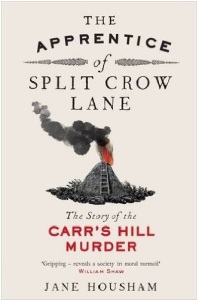A Graph Review 55 with high points to 65:
The Apprentice of Split Crow Lane
(The story of the Carr’s Hill Murder)
by Jane Housham
Published by Riverrun, November 2016
Hardback. £20.00. ISBN 978 178648 158 0
 The central theme is the brutal murder of a five year old girl and a highly researched telling of that story. Another, all encompassing theme is of local history-cum-social history around the period which unerringly links back to the central theme’s characters. There is a substantial gathering of background scenery covering: living, labouring, policing, legal, medical and even the ‘politiking’ of the time and years prior to the murder. Plus of course the careful analysis of the written evidence, newspapers and reports of and around the conviction and its aftermath.
The central theme is the brutal murder of a five year old girl and a highly researched telling of that story. Another, all encompassing theme is of local history-cum-social history around the period which unerringly links back to the central theme’s characters. There is a substantial gathering of background scenery covering: living, labouring, policing, legal, medical and even the ‘politiking’ of the time and years prior to the murder. Plus of course the careful analysis of the written evidence, newspapers and reports of and around the conviction and its aftermath.
A map is included of the relevant area, useful for me as the movements of numerous people are specified through different sections of the book.
Details of the police work, autopsy and inquest are carefully collated from assorted libraries, National Archives and newspaper records and clearly narrated as events progressed.
It is interesting to read of these now-historic procedures and be informed how and when some changes towards our current practices came about. Just as interesting is how the models of procedure were being established and how use of forensic analysis was developing.
Moving on, the book explores and explains the fledgling positions of psychiatric analysis and the also the magistrate and county courts. The author expertly weaves the events of the day from numerous accounts, official or newspaper into narrative as well as using current knowledge of routines to balance the historic methodology. References abound for referring to at the back of the book, along with a thorough bibliography and index.
From the explorations in this book the movement towards more sensitive and scientific judiciary and medical (emerging psychiatric) systems is well under way by the mid 19th Century. A more humane face of all is offered here than you might have expected if you relied on Dickens. Admittedly Charles Dickens was writing from aslightly earlier date and was depicting the worst excesses of a city (London bias). He was at the forefront, as were many at this period, of pushing society forward.
1815…. Edward Wakefield report published 1815. Report of his visit to Bethlem hospital where amongst other things he had ‘seen both men and women, sometimes naked, chained to poles and strapped inside harnesses that inhibited almost all movement’. Leading reformer Thomas Wakley introduced a more sympathetic, ‘Humane System’ in 1841 which opened asylums to official visitors and a separation of violent and non-violent inmates plus an end to restraints. Additionally, more staff. The movement towards better conditions and freedoms had been publicly advocated by reformers in the early years of the century and continued throughout. Broadmoor opened in 1863 by when the system proposed by Wakeley was well established throughout the country. (See page 179 for description of ‘life in the new humane asylum’)…… note…. Clare’s last asylum seems to have been nearer to these ideals than many other county asylums. perhaps his celebrity status as a poet secured him best conditions, not forgetting that he may have been getting visits from other well-known, and articulate, friends and interested/influential people.
This story extrapolated from notes, reports and letters of Cuthbert’s life in the asylum is compellingly drawn, the story drifting to a sad end with his family moved to Canada and the inclusion of letters from his father to the authorities at Broadmoor.
But this is not the end of the book. Another, similar case is briefly discussed following with the legal result. More follows with the discussions, arguments even, as to where insanity lies in the commitment of crime. Again Carr’s case comes into this arena and judgements and texts are quoted from what became definitive books of the day on where accountability sits.
Maybe more could have been said of the degenerative effects of STDs as they seem accepted as widespread and to have had a marked effect on society of the day. However as this seems little discussed in the case notes it is understandable.
There is a fascinating look at the reasoning and development of medical and legal definitions of insanity and movements towards considerate treatment of those considered insane throughout the nineteenth century. The murder by Cuthbert Carr is the central case but later introducing others to demonstrate legal and medical practitioners’ positions in mental capability. Press and public opinion is well documented here as well as police, legal and medical (asylum) practice over a period where Victorian values were searching for the higher ground despite the still harsh grinding of the industrial revolution.
And all topped off with an appropriate poem by Vernon Scannell.
